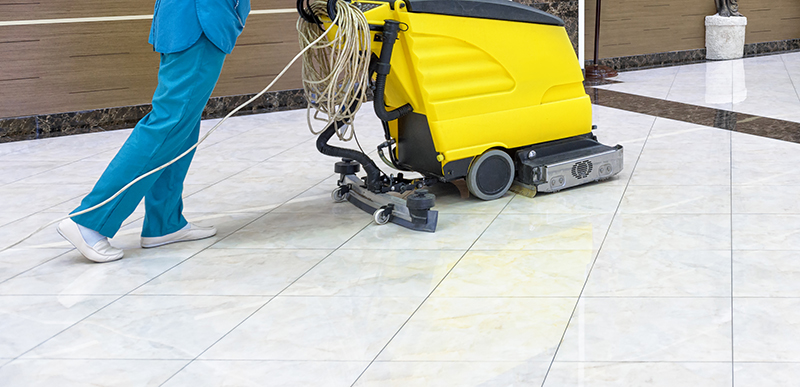
For years, people assumed there was a basic level of cleanliness in public spaces. That’s no longer the case. Trust has been eroded due in large part to the COVID-19 pandemic. Indeed, as Ernst & Young wrote, the age of the “anxious consumer” is upon us.
And if consumers are anxious, educators, parents, and students are too. They demand that their schools and universities be clean, safe environments where learning can occur free of public-health hazards.
Meeting this higher level of cleanliness poses unique challenges to managers responsible for cleaning educational institutions. Labor often makes up half of their budget, and the cost to hire, train, and keep employees is higher than ever—and it keeps going up.
According to the Bureau of Labor Statistics, the overall cost of labor increased by 2.4% in 2020, while the cost to train a new employee is roughly $1,000. What’s more, the legal landscape is changing. The minimum wage will increase in 25 states in 2021, and overtime laws now require employers to pay salaried employees more or convert them to nonexempt status.
The combination of these factors will likely lead many cleaning and maintenance managers to prioritize productivity improvements. For many, that means mechanization. But much of the increased cleaning required in our new normal can’t be done with a machine. A human must perform surface disinfection and other high-touch tasks.
Even so, managers are achieving improved employee productivity by mechanizing some aspects of cleaning. Specifically, floor cleaning is a great task to mechanize.
Mechanizing the Mop
Floor cleaning has come a long way. Archeologists believe that the first rudimentary broom dates to 2,300 B.C. Over the next 4,100 years, humans worked to perfect floor cleaning. The first use of the word “mop” dates to 1496, then spelled “mappe.” String mops as we know them weren’t patented until 1893, and sponge mops hit the market in the 1950s.
These instruments often spread dirt and grime around on the floor, and using one is often a labor-intensive, time-consuming, and dirty job. Modernizing the mop has made floor cleaning more manageable. Micro-scrubbers provide powerful cleaning technology and speed up floor cleaning, allowing employees to focus on the more intensive cleaning the public demands.
Advantages of Mechanized Cleaning
Along with increased employee productivity, mechanized scrubbers offer benefits to facility cleaning managers.
First, mitigating public health risks is more important than ever before, and clean floors create safe spaces to learn, work, and play. Automatic scrubbers use significantly cleaner water than the humble mop-and-bucket method. Reusing pathogen-containing dirty mop water cross-contaminates any surface it touches.
Second, employees can clean floors significantly faster with a fleet of micro-scrubbers, providing employees more time to sanitize doorknobs, counters, faucets, and other high-touch surfaces. These scrubbers are ideal for the education and university environments, as they are often quiet enough to use during school hours and can fit into tight corners.
Third, scrubbers reduce the number of slip-and-fall injuries. According to the Centers for Disease Control and Prevention (CDC), a single injury of this sort can cost an employer $40,000, so cutting down on these accidents is paramount to cost savings as well as safety for employees and students. Micro-scrubbers reduce this risk by recovering nearly 100% of the water used to clean. Drying times are faster, eliminating large swaths of wet, potentially dangerous floors and getting areas back in service almost immediately.
Fourth, aesthetics are important. No one likes to see a bucket of dirty mop water in hallways, bathrooms, cafeterias, and breakrooms. But students, staff, and parents want to know that cleaning is happening. Micro-scrubbers are safe and quiet to use when people are present. Doing so demonstrates that cleaning is taking place, but it’s not overly disruptive or unsightly.
Fifth, automatic scrubbers clean multiple types of hard surfaces. They can address light-duty, everyday cleaning or more in-depth scrubbing and scouring. Automatic floor cleaners combine high-pressure scrubbing with effective detergents to outperform any manual mop-and-bucket method. In one laboratory test, the micro-scrubber cleaned surfaces 90% more effectively than a traditional mop (the test measured the amount of adenosine triphosphate [ATP] left after cleaning a surface using both methods).
Finally, and perhaps most important, automatic scrubbers save money. By using high-pressure scrubbing and effective cleaning solutions, mechanized floor cleaners use less water and less product. Modern micro-scrubbers are energy efficient, too, utilizing lithium-ion batteries so that there is less dependence on nonrenewable energy sources, indoor air quality is improved, and staff doesn’t spend as much time maintaining traditional batteries.
Given the focus on providing clean, safe environments for learning, today’s modern micro-scrubber floor cleaners improve employee productivity while cleaning floors better than traditional methods can. They’re quiet, unobtrusive, and consistent. Keeping up with “what’s new” has always been a challenge, whether it’s new trends, new expectations, or new technologies—and one of the biggest trends today is the experience you deliver to the user. By leveraging modernized floor-cleaning technologies, facility managers can rapidly create an experience that stands out from the crowd, earning invaluable trust and driving measurable business value. Just as critically, deploying these simple tools can rapidly power operational efficiency, productivity, and staff satisfaction that drives the bottom line of your success.
Angie Hennessy is global senior product marketing manager at Tennant Company, Minneapolis, MN, and can be reached at [email protected]. This is her first article for Facilities Manager.
Power Tools
Seeks to engage multiple voices from among FM ranks to bring fresh insight and real knowledge from the trenches on what’s working in planning and implementation for energy-related projects and innovations. To contribute, contact [email protected].
See all Power Tools.


